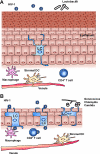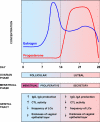Sex steroid hormones, hormonal contraception, and the immunobiology of human immunodeficiency virus-1 infection
- PMID: 19903932
- PMCID: PMC2852204
- DOI: 10.1210/er.2009-0018
Sex steroid hormones, hormonal contraception, and the immunobiology of human immunodeficiency virus-1 infection
Abstract
Worldwide, an increasing number of women use oral or injectable hormonal contraceptives. However, inadequate information is available to aid women and health care professionals in weighing the potential risks of hormonal contraceptive use in individuals living with HIV-1 or at high risk of infection. Numerous epidemiological studies and challenge studies in a rhesus macaque model suggest that progesterone-based contraceptives increase the risk of HIV-1 infection in humans and simian immunodeficiency virus (SIV) infection in macaques, accelerate disease progression, and increase viral shedding in the genital tract. However, because several other studies in humans have not observed any effect of exogenously administered progesterone on HIV-1 acquisition and disease progression, the issue continues to be a topic of intense research and ongoing discussion. In contrast to progesterone, systemic or intravaginal treatment with estrogen efficiently protects female rhesus macaques against the transmission of SIV, likely by enhancing the natural protective properties of the lower genital tract mucosal tissue. Although the molecular and cellular mechanisms underlying the effect of sex steroid hormones on HIV-1 and SIV acquisition and disease progression are not well understood, progesterone and estrogen are known to regulate a number of immune mechanisms that may exert an effect on retroviral infection. This review summarizes current knowledge of the effects of various types of sex steroid hormones on immune processes involved in the biology of HIV-1 infection.
Figures


References
-
- Shah I 2005 Contraceptive use patterns in countries with different levels of HIV epidemic. J Acquir Immune Defic Syndr 38(Suppl 1):S5–S6 - PubMed
-
- 2008 World contraceptive use 2007. UN report. New York: United Nations
-
- Cates W 2001 Use of contraception by HIV-infected women. IPPF Med Bull 35:1–3
-
- Guimarães MD, Muñoz A, Boschi-Pinto C, Castilho EA 1995 HIV infection among female partners of seropositive men in Brazil. Rio de Janeiro Heterosexual Study Group. Am J Epidemiol 142:538–547 - PubMed
Publication types
MeSH terms
Substances
Grants and funding
LinkOut - more resources
Full Text Sources
Medical

